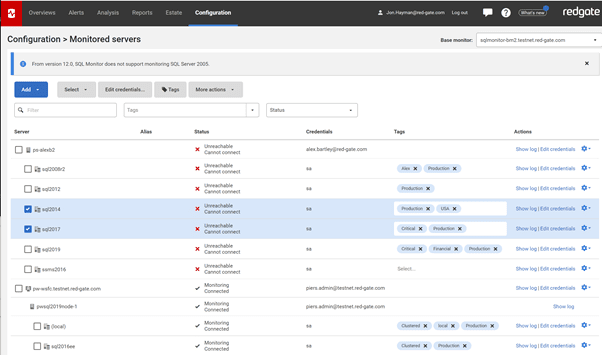Tagging in a monitoring tool: what is it and how can it benefit your team?
We recently released a minor version of SQL Monitor, v12.1, that includes two exciting new features: ‘Tagging’ and a ‘Current Activity’ page. Find a post on the latter here.
As you start to have responsibility for more than a handful of SQL Server instances, you’ll need to get more organised. Everyone around you benefits if you’ve recorded basic things like what the server does and who is responsible for it, and we think that a great place to do this is in your monitoring tool (and, better still, if that’s SQL Monitor!).
For this reason, we’ve recently introduced tags into SQL Monitor. You can use tags to record information on your SQL Server instances, Azure SQL Databases, Azure Managed Instances and AWS RDS instances. By introducing this into SQL Monitor, the information you need is right at your fingertips when you come to investigate issues on the server. It can also be used to filter the estate-wide views that SQL Monitor presents to show just the servers you are particularly interested in, helping you to see the wood from the trees.
There are many aspects of your servers that you could use tags to record. We’d love to hear more about how you might use tags (more on that later), but here are some of our ideas:
- Who the business owner of the server is, so that you know who to contact when there is an issue
- What application they support
- The responsible DBA or SQL Monitor user, so that they can filter alerts and the SQL Monitor dashboard to
- Where the server is geographically located
- An indication of the server’s SLA
How to tag your servers
Getting going with tags is extremely easy, and we’ve tried to make it simple for you to operate in bulk so that you can gain value from them efficiently. You can either apply tags to servers on the Monitored Servers configuration page or directly on the Server’s Overview page.

On the Monitored Servers configuration page, you’ll find a tag area next to each SQL Server instance, Azure SQL Database, Azure Managed Instance and AWS RDS Instance. Simply click in the area and begin to type the tag you want to add. If you’re retrospectively trying to arrange your servers and have a tag that you want to apply to more than one server, tags can be added in bulk: use the checkboxes on the left to select the servers and then click the “Tags” button.
Where can I see tags? Where can I filter using tags?
We’ve aimed to allow you to see and filter by tags throughout SQL Monitor. You can filter the Global Dashboard, Alert Inbox and all the Estate pages by tag. Selecting multiple tags will show you servers that have all the selected tags applied.

Tags are also shown on the Server Overview to provide you with additional information on the server you’re looking at when you need it. For the same reason, tags are also presented alongside alerts, both on the alert details page and with any email sent by SQL Monitor, and with outgoing webhook packets.
On the Server Overview, the tag area is editable, which is ideal if you find something that you want to record whilst you’re looking specifically at that server. Just click in the tag area and you’ll be able to add a new tag or to edit the existing tags.

What’s next?
We hope that you’ll find this new feature valuable. We’d love to hear your experience of using it and any thoughts you have on how we should take it further: just drop us an email at sqlmonitorfeedback@red-gate.com or send the feedback directly using the ‘speak to us’ link at the top of your SQL Monitor session.

Tools in this post
Redgate Monitor
Real-time multi-platform performance monitoring, with alerts and diagnostics